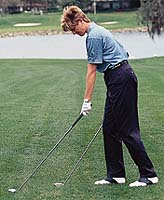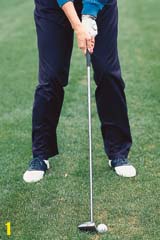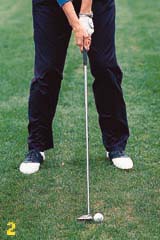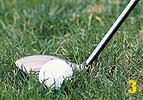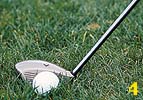Check the lie before you choose which fairway wood to hit
Technological advances in fairway woods have been a boon to amateurs, especially those who struggle with distance. However, if you’ve added one or more of these clubs to your bag, you may have noticed they don’t always produce the perfect shot.
Have you ever topped a ball with your 3-wood? Or launched a moon-shot with your 7-wood? Maybe it wasn’t the club that let you down. More than likely, you were tricked by the lie. With fairway woods, it’s vitally important to know how the lie can affect performance.
THIN LIE
From a thin lie, the deep face of a 3-wood (left) sits mostly above the ball. A 7-wood’s shallow face sits fully behind the ball (right).
Consider a common scenario: Your approach shot requires 3-wood distance, but the ball is sitting down — on a bare patch in the fairway or a thin patch of grass in the rough. Though the distance calls for a 3-wood, it’s the wrong club for the shot. Place the head of the 3-wood behind the ball and most of the clubface, including the sweetspot, is above the ball (photo 1). Only a small part of the clubface will make contact, sending the ball skimming along the ground.
The right choice is a wood with a smaller head and shallower face, such as a 7-wood. When you place the 7-wood behind a ball slightly below ground level, the bulk of the face, including the sweetspot, is mostly behind the ball (photo 2). And you don’t have to worry about less distance with the more lofted wood: the tight lie guarantees you’ll hit the ball slightly thin, which produces overspin rather than backspin and causes the ball to fly farther than it would from a normal lie.
FLUFFY LIE
For an extremely fluffy lie, use your 3-wood: Its deep face provides an expanded hitting surface for a greater margin of error (photo 4). To reduce the club’s distance potential, grip down so your lower hand is at the bottom of the grip, just above the shaft; also, expect your shot to fly on a lower, 3-wood trajectory.
SELECT THE RIGHT WOOD
